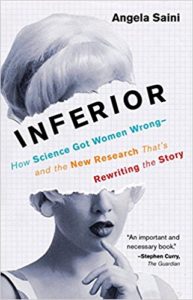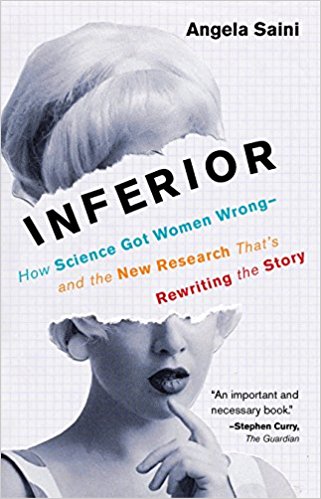Inferior:
How Science Got Women Wrong—
and the
New Research That’s Rewriting the Story
by Angela Saini
 I love science and history and truly enjoy it when they overlap in books such as Inferior: How Science Got Women Wrong—and the New Research That’s Rewriting the Story. As a feminist, I keep up with gender-based research and have for several decades. Disproving bad science that stated women’s minds, bodies, and emotions were inferior to men’s was a key element of my job when I worked with school systems to implement Title IX in the 70’s. Title IX was known as “the law that will destroy boys sports” in football-crazy Ohio and basketball-obsessed Indiana where I did most of my work. Maybe those coaches and teachers were right. Look who took home most of the medals on the US teams from the last two Olympics. But Title IX was about so much more than sports. It guaranteed equal access for girls and women to all aspects of education.
I love science and history and truly enjoy it when they overlap in books such as Inferior: How Science Got Women Wrong—and the New Research That’s Rewriting the Story. As a feminist, I keep up with gender-based research and have for several decades. Disproving bad science that stated women’s minds, bodies, and emotions were inferior to men’s was a key element of my job when I worked with school systems to implement Title IX in the 70’s. Title IX was known as “the law that will destroy boys sports” in football-crazy Ohio and basketball-obsessed Indiana where I did most of my work. Maybe those coaches and teachers were right. Look who took home most of the medals on the US teams from the last two Olympics. But Title IX was about so much more than sports. It guaranteed equal access for girls and women to all aspects of education.
I knew about many of the studies described in this book, but it was still educational seeing them all pulled together and analysis of their techniques and possible biases hashed out. One of my favorite chapters dealt with brain science. Try as they might, neurologists and endocrinologists cannot find differences between the brains of males and females. There is far more variation within each sex than between them. Another favorite chapter was on women’s sexuality which explored in depth the myth that women were naturally more modest, choosy, and had lower sex drives than men (only in those societies that demand it of women and punish the non-conformers). In all the chapters but one Saini comes to conclusions based on the evidence. Her final chapter is ambiguous and (as a woman of a “certain age”) my favorite. “The Old Women Who Wouldn’t Die” looked at the evolution of women living after menopause.
There are only a handful of species, including killer whales, where the females continue to live and thrive after their childbearing years are over. She discusses the “grandmother theory” which posits that a few long-lived females way back in the mists of time were able to contribute additional resources and important knowledge that favored their daughters and grandchildren. This set up a virtuous cycle that resulted in human females living well-past child bearing years. The competing “rich old man” theory hypothesizes that a few long-lived high status males had access to many females and passed on their long-life proclivity to their offspring including daughters. You can imagine which theory I favor, but there isn’t enough evidence or ways of studying to come to any provable conclusion. We’ll just have to live with all of us old broads continuing to positively contribute to society long past the time when we’re “useful” as incubators.
I found the book quite readable, but I like this kind of thing. Saini does a great job of putting the science in historical and social context. She is NOT “male bashing.” Individual men who did poor science or let a male agenda color their conclusions, might feel pinched. But this is not a “women are better in every way” book. It shows how science was used to marginalize women, as the basis for laws and societal norms. By updating that science, Saini demolishes those arguments for keeping women from having equal access to all the advantages of modern life. She writes plainly and gives lots of background for the studies, so you don’t have to read them yourself. This was an ARC and I missed the index which will be in the final version. Highly recommended for casual science geeks and people who like women. Misogynists and fundamentalists of all stripes should give it a pass. I learned long ago before the current post-fact fad, that people with biases can’t be persuaded with facts. However, sometimes–just sometimes–they can be persuaded with stories and personal connections.
Note: I received this book through an Early Reader program in exchange for an honest review.
